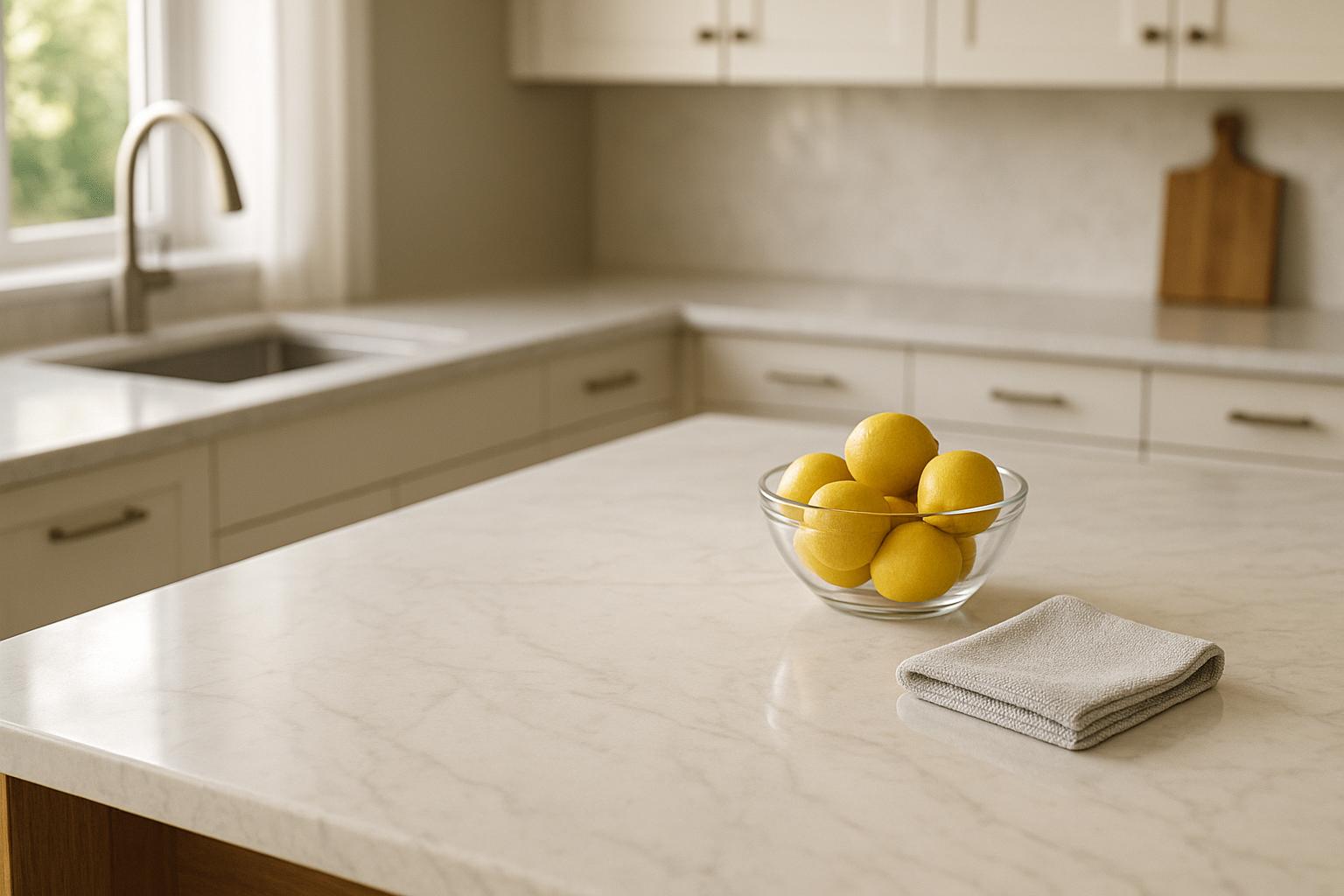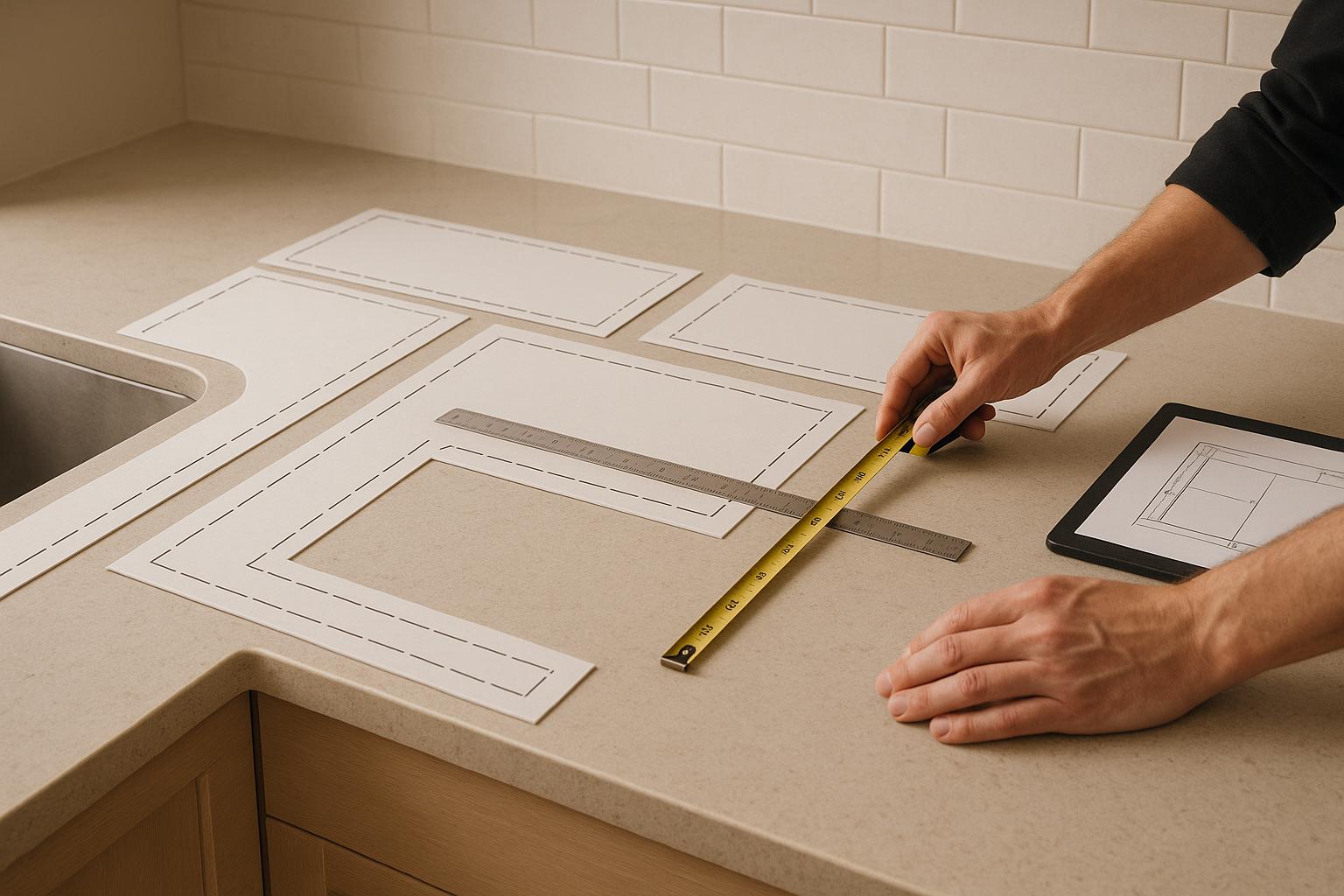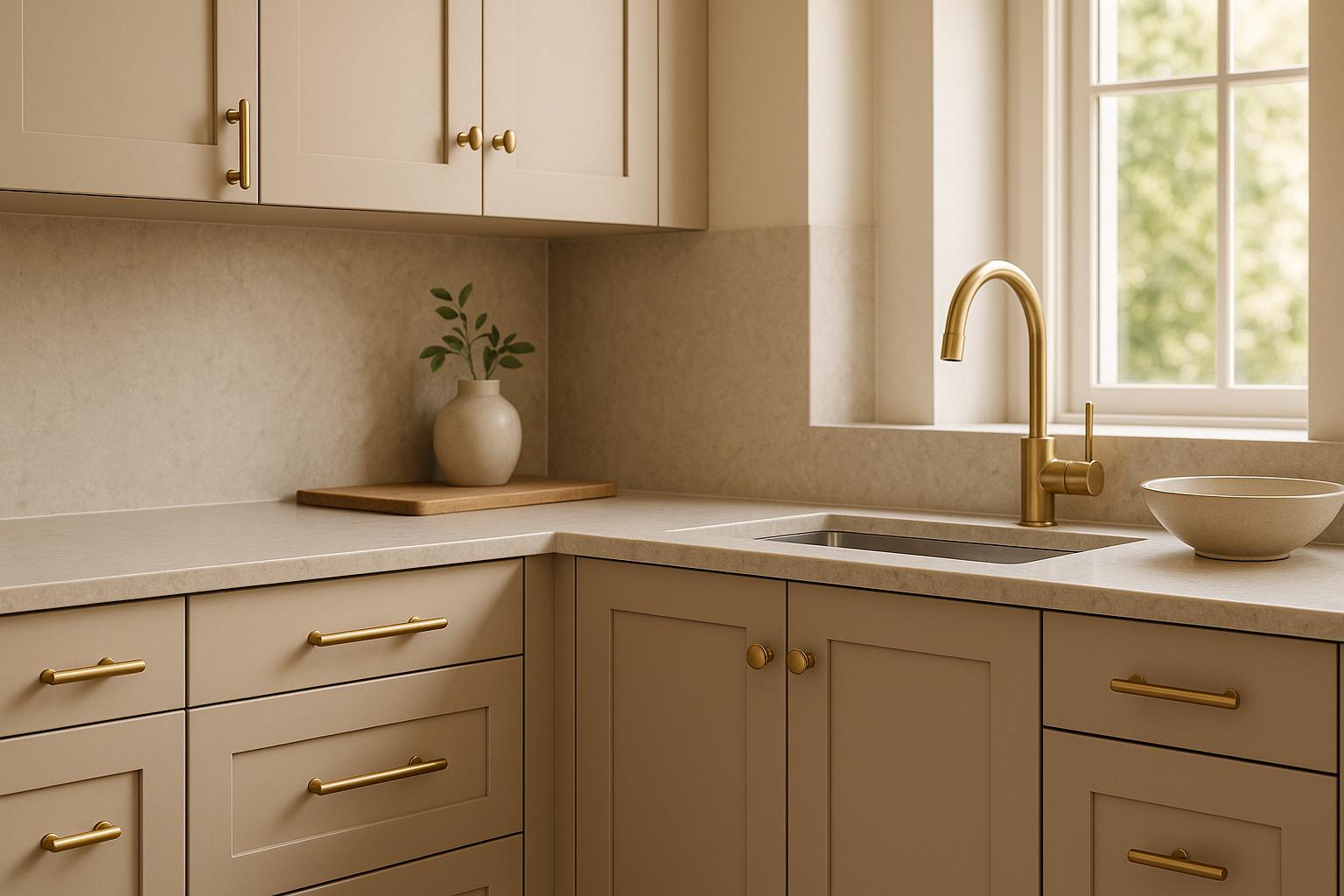Marble looks stunning but can lose its shine due to etching – damage caused by acids reacting with its surface. Preventing etching is easier than fixing it, and here’s how you can protect your marble:
- Avoid acidic foods and drinks: Citrus, tomatoes, vinegar-based items, wine, and coffee can cause damage quickly.
- Use the right cleaners: Stick to pH-neutral products. Avoid vinegar, lemon-based cleaners, and anything abrasive.
- Change kitchen habits: Always use cutting boards, clean spills immediately, and avoid placing hot pans directly on marble.
- Daily care: Dust weekly, blot spills instead of wiping, and use soft microfiber cloths for cleaning.
- Regular maintenance: Test your marble’s seal every few months and reseal as needed to minimize stains (though it won’t stop etching).
If etching happens, minor spots can be treated with marble polishing powder, but severe damage may require professional help. Prevention is key – small changes in how you use and care for marble can save you from costly repairs later.
Marble 101: Common Type of Natural Stone Damage- Etching
What Causes Etching
Knowing what leads to etching can help you safeguard your marble countertops from potential damage. Surprisingly, many everyday kitchen items are the culprits, making awareness your best defense. Let’s break down the specific factors that contribute to etching.
Acidic Foods and Drinks
Certain foods and drinks can wreak havoc on marble surfaces due to their acidic nature. Here are some of the most common offenders:
- Citrus fruits: Lemons, limes, oranges, and grapefruits are packed with citric acid, which can etch marble in minutes. Even a few drops of lemon juice can cause visible damage.
- Tomato-based products: Fresh tomatoes, marinara sauce, ketchup, and salsa contain acids that harm marble. The longer these items sit on the surface, the more damage they cause.
- Vinegar-based items: Salad dressings, pickles, mustard, and marinades containing vinegar are highly acidic and can etch marble immediately upon contact.
- Wine and alcoholic beverages: Red wine, in particular, contains tartaric acid, which not only etches but also stains marble. Beer and champagne can also gradually wear down the surface.
- Coffee and soft drinks: Phosphoric acid in cola and natural acids in coffee can dull marble’s polished finish if spills aren’t cleaned up quickly.
But it’s not just food and drinks – cleaning products can be just as damaging.
Wrong Cleaning Products
Using the wrong cleaners is a common mistake that can lead to widespread etching. Many household products are simply too harsh for marble:
- Household and bathroom cleaners: Products containing acids like hydrochloric, sulfuric, or phosphoric acid can strip away marble’s protective finish and leave behind etching.
- Glass cleaners: These often contain ammonia or acidic ingredients that dull marble surfaces over time. While great for windows, they can permanently damage marble countertops.
- Natural cleaners: Despite their popularity, natural options like vinegar and lemon juice are among the worst choices for marble. The "natural" label doesn’t mean they’re safe for natural stone.
Beyond products, certain habits in the kitchen can also increase the risk of etching.
Kitchen Habits That Increase Risk
The way you use your marble countertops can make them more vulnerable to damage. Here are some habits to watch out for:
- Cutting citrus directly on the countertop: Slicing lemons or limes without a cutting board spreads acidic juice over a larger area, giving it more time to react with the marble.
- Delaying cleanup of spills: Allowing spills to sit gives acids time to penetrate the surface, causing noticeable etching in mere minutes. Quick cleanup is crucial.
- Using marble as a prep surface: Preparing acidic ingredients like tomatoes or berries directly on the countertop can transfer acids to other areas, increasing the risk of damage.
- Placing hot pans on marble: Heat opens the stone’s pores, making it easier for acids to seep in and cause damage when spills occur later.
- Wiping spills with the wrong materials: Paper towels often spread acidic liquids around instead of removing them, while abrasive sponges can scratch the surface, creating even more areas for acids to settle.
Daily Cleaning and Care
Taking care of your marble countertops daily is the best way to protect them from etching and other damage. A consistent cleaning routine not only keeps them looking great but also helps prevent small issues from turning into permanent damage.
Use pH-Neutral Cleaners
When it comes to cleaning marble, the golden rule is to stick with pH-neutral products. Marble is made of calcium carbonate, which reacts poorly to acidic or highly alkaline substances. The safest approach? Use cleaners specifically designed for stone or a mild dish soap mixed with warm water. A quick tip: add a few drops of dish soap to a spray bottle filled with water for a simple, effective solution. Avoid cleaners containing vinegar, lemon juice, bleach, ammonia, or oil-based soaps – they can harm the surface.
Choose the Right Tools and Techniques
The tools you use matter just as much as the cleaners. Soft microfiber cloths are perfect for marble because they gently remove dirt and absorb liquid without scratching. For spills, blot them immediately rather than wiping back and forth – this prevents acidic liquids like wine, coffee, or citrus juice from spreading. Stay away from abrasive tools like scouring pads, steel wool, or rough brushes, as these can scratch the surface and make it more prone to damage. For tougher stains, try a baking soda paste covered with plastic wrap and let it sit for up to 24 hours.
Keep Up with Regular Maintenance
A little maintenance goes a long way in preserving your marble’s elegance. Dust weekly to prevent dirt buildup that can cause scratches. After cleaning, take an extra moment to dry the surface with a clean microfiber cloth. Gently buffing the marble not only keeps it shiny but also prevents water spots and mineral deposits from forming. While water spots might seem harmless, drying your countertops thoroughly can help maintain their polished finish and reduce the risk of bacterial growth or water stains.
sbb-itb-e397dd0
How to Protect Your Marble
Once you’ve nailed down the basics of daily care, it’s time to step up your game with some extra protective measures. These steps help shield your marble from acid damage, keeping it looking gorgeous and saving you from costly repairs down the road.
Keep Acids Away
The best way to prevent etching is to create a barrier between your marble and anything acidic. For starters, always use a cutting board when working with acidic foods like tomatoes, lemons, or oranges. This simple habit can save your marble from accidental exposure.
Also, avoid placing glasses or cans directly on your marble countertop. Condensation rings might seem harmless, but they can lead to etching over time. And don’t forget – while acids are the main culprits, even non-acidic substances can damage the surface if left sitting too long.
If a spill happens, act fast! Blot it up with a paper towel instead of wiping. Wiping can spread the acid, making the problem worse. Quick action here can make all the difference in protecting your marble’s finish.
Fixing Etched Marble
Even with careful maintenance, etching can sometimes happen. If it does, don’t worry – there are ways to repair it. Whether you can handle it yourself or need professional help depends on the severity of the damage.
Minor Etching Repairs
For light etching, you can often fix it yourself using marble polishing powder. This method is ideal for small spots where the marble looks dull or has faint blemishes that become more obvious when wet.
Start by cleaning the area with a pH-neutral cleaner and letting it dry completely. Then, apply a small amount of polishing powder to the etched area. Using a soft cloth, gently rub the compound in circular motions, applying light pressure to avoid uneven results.
Keep in mind that DIY fixes are typically short-term solutions. They may improve the appearance but won’t fully restore the marble’s original shine or provide long-lasting protection.
When to Call Professionals
If the etching goes beyond surface-level damage, it’s time to consult an expert. Deep scratches or changes in the marble’s texture often require professional attention.
"For more prominent scratches, seeking professional help is the best way around this situation, as they have the tools and skills to handle it." – Granite Heroes
Signs that you need professional restoration include a rough or dull surface that doesn’t improve with cleaning. Experts use advanced techniques like honing or resurfacing, along with industry-grade compounds, to bring back the marble’s original gloss.
"While DIY solutions may temporarily mask the problem, professional restoration polishes away etching and protects the surface with proper sealants." – Natural Stone Services
MI Stone, known for their expertise in natural stone restoration, is a trusted choice for tackling serious marble damage. Their team understands the unique needs of different marble finishes and can recommend the best restoration strategy. Instead of risking further harm with incomplete DIY attempts, their professionals assess the damage and use the right tools and methods to restore your marble’s beauty.
Addressing etching early can save you from more expensive repairs down the line.
Final Tips
Building on the daily care and protection methods we’ve covered, these additional tips can help you stay ahead in maintaining your marble’s beauty. A combination of quick spill cleanup, the right cleaning products, and regular upkeep is key to keeping your marble in top shape.
Act quickly when spills happen. Acidic substances like lemon juice, wine, or tomato sauce can etch marble in just minutes. Always blot spills instead of wiping to avoid spreading them further. Follow up immediately with a pH-neutral stone cleaner to clean the area thoroughly. This simple step can save you from costly repairs down the line.
Stick to pH-neutral cleaners and soft materials. Avoid harsh cleaners such as vinegar or lemon-based products, as well as abrasive tools like scouring pads. These can dull or damage your marble’s surface over time.
Use protective barriers. Incorporate cutting boards, coasters, and placemats into your routine to shield your marble from acids, oils, and other potential hazards. These small accessories act as a first line of defense.
Test and reseal periodically. Every few months, test your marble’s seal by pouring a small amount of water on the surface. If the water darkens the stone within 30 minutes, it’s time to reseal. While sealing won’t stop etching, it can reduce the risk of stains. Depending on how often the surface is used, resealing every three to six months is recommended.
Choose your finish wisely. If you’re installing new marble, consider the finish carefully. A honed finish is less reflective and can help mask etching compared to a polished surface. This choice can make minor imperfections less noticeable over time.
For personalized advice and expert solutions, MI Stone offers professional fabrication and tailored care strategies for all types of marble finishes. Their expertise ensures that you start with the right protection plan for your specific needs.
Prevention is always more affordable than repair. Neglecting marble care can lead to permanent dull spots or expensive restoration work. One homeowner shared their experience of maintaining marble for three years without visible etching or staining by following a consistent routine: daily cleaning with pH-neutral products, using protective accessories, and resealing every six months. This highlights how effective these habits can be.
Incorporate these practices into your daily routine, and your marble can remain stunning for decades to come.
FAQs
How do I know if my marble countertop needs to be resealed, and how often should I check?
To determine if your marble countertop needs resealing, you can use the water test. Simply pour about a tablespoon of water onto the surface and let it sit for 10–15 minutes. If the water beads up, your seal is holding strong. However, if the water starts to soak into the marble or spreads out, it’s time to reseal.
Performing this test every 6–12 months is a smart habit, especially if your countertop gets a lot of use. Regular checks like this ensure your marble stays protected and maintains its beautiful appearance.
What should I do if I accidentally use an acidic cleaner on my marble countertop?
If you’ve mistakenly used an acidic cleaner on your marble countertop, quick action can help reduce the damage. Start by thoroughly rinsing the area with warm water to wash away any leftover cleaner. Next, create a paste using baking soda and water – this can neutralize the acid and help lift any stains. Gently apply the paste to the damaged spot, let it sit for a few minutes, and then wipe it off with a soft, damp cloth.
For everyday cleaning, stick to a mild mix of dish soap and warm water. Steer clear of acidic or abrasive products like vinegar, lemon juice, or bleach, as these can etch the surface and dull the marble’s finish. If the damage is extensive, it might be time to consult a professional for restoration.
Can marble etching be fully repaired, or will it always leave permanent marks?
Marble etching is often fixable, particularly when the damage is minimal. Light etching can typically be polished away, bringing back the surface’s smooth and even look. For more pronounced etching, you might need professional help. This process usually involves carefully removing a thin layer of the stone to create a consistent finish.
That said, in cases of severe etching, some faint marks may remain visible even after repairs, depending on the damage’s depth. To help prevent etching and keep your marble in great condition, regular upkeep and applying protective sealants are highly effective.



